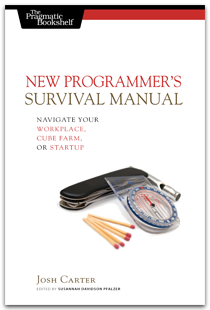I have over a decade of professional C++ experience, but I don’t call
myself a “C++ Programmer.” Am I competent with programming in C++?
Yes, very much so. But I refuse to let my skills be pigeon-holed by
the language I’ve historically used. Nor should you.
Use the right tool for the job, the saying goes, and software
development is no exception. Programming languages, frameworks, and
other tools are the subject of religious-caliber debate but they are
just means to a greater end. This article is a call to both
programmers and their managers: a good programmer cannot be summed up
by the list of tools they use.
JET very kindly unearthed a treasure chest containing the One
True ROM Image for DataRover 840s, a PC Card that will flash a 840’s
ROM to Magic Cap 3.1.2j. This card can be used to re-flash a ‘rover
with no additional hardware. (See also this article for
reflashing a ‘rover using the developer tools and serial cable.) You
can download the ROM image from the archives page and load it to
a 8MB linear flash card yourself, or if you need a pre-flashed card
mailed to you, contact me.
Note: if you bought a DataRover on eBay that has pre-release Rosemary
firmware (usually dated 9/1/1997), that won’t work with the packages
in the archive. It’s best to update to 3.1.2j.
Last night I attended the inaugural meeting of the Boulder-Denver
Ruby User’s Group. “Meeting” was a term used in the loose
sense–it was more a gaggle of Ruby enthusiasts sitting around tables
with beer, chatting about Ruby and other geek stuff. The meeting was
held at a brewery, so it was impossible to hear people more than a
couple feet away, but as the group shifted around I probably talked
with half a dozen others.

I’ve done a heck of a lot of typing over the past ten years, and my
keyboards show it. They look grimy and beaten down, but continue to
work flawlessly. After doing a rubik’s cube paint job on my first
Kinesis keyboard, I decided I’d fix up another, this time applying
lessons learned from the first. This article describes to you can
create your own New Hotness like mine pictured above.
These are documents from the Magic Cap SDK which may be of interest to the community, particularly those into software development and usability. Warning to developers digging for ideas: some topics discussed in these docs are covered by patents.
Using Magic Cap: User-level documentation for Magic Cap 3.1, i.e. what runs on the DataRover 840. Recommended to anyone who hasn’t seen/used Magic Cap in person.
Design and Magic Cap: An older document covering the design and usability of Magic Cap, targeted at application designers.
When I first moved to Silicon Valley I worked crazy hours. I loved my
job and I needed to prove myself, so I was coding like crazy. That
translates to typing like crazy, and it wasn’t long before that caught
up with me. This article covers my ensuing experience with ergonomic
keyboards and the Dvorak keyboard layout.
Rewind to 1995. I could type pretty fast on a normal keyboard. My
touch typing was not textbook proper, but hey, it worked fine for me.
I started getting worried when I would go home and I could still feel
the tension in my forearms and wrists. I figured that if I was going
to be a programmer geek for any decent amount of time, I’d have to fix
those problems pronto.
I got to talking to Eric Townsend, a coworker of mine who owned the
wackiest keyboard I had ever seen. It was a Kinesis Contoured
keyboard. I found myself fascinated enough to drop the $300 (at
the time) to get one myself.
Question: Whatever became of Magic Cap? Will it ever be released into the public domain? Is OpenMagic happening behind closed doors somewhere?
Answer: Unfortunately, no. Here’s the story according to Steve Schramm, former General Manager of the Magic Cap division and CEO/President of DataRover/Icras:
Andy [Hertzfeld] strived to open Magic Cap at the time of the GMGC bankruptcy. If I remember Andy’s explanation correctly, Nathan Myrvold, formerly of Microsoft, used the bankruptcy process to capture the IP after Andy Hertzfeld working with Andy Rubin had won two previous decisions to get the Magic Cap IP.
 Operating System: Magic Cap pre-1.0.
Pros: Slim form factor, cool looks (perhaps the coolest).
Cons: Awful screen, custom battery, difficult left-handed operation.
History Bamboo was a mystery to me: definitely before my time at General Magic, I remembered only seeing references to it in the Magic Cap 1.x source code. But when I asked around among other ex-Magicians, nobody else knew about it, either. When I told Mark ‘The Red’ Harlan I had discovered one, he said: “AWESOME.
Operating System: Magic Cap pre-1.0.
Pros: Slim form factor, cool looks (perhaps the coolest).
Cons: Awful screen, custom battery, difficult left-handed operation.
History Bamboo was a mystery to me: definitely before my time at General Magic, I remembered only seeing references to it in the Magic Cap 1.x source code. But when I asked around among other ex-Magicians, nobody else knew about it, either. When I told Mark ‘The Red’ Harlan I had discovered one, he said: “AWESOME.






